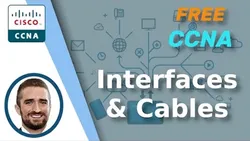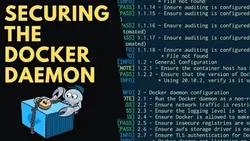
Free CCNA Interfaces and Cables Day 2 CCNA 200-301 Complete Course 
This course provides an introduction to interfaces and cables, including RJ-45, Ethernet, network protocols, bites and bytes, Ethernet standards, UTP cables, 10BASE-T, 100BASE-T, straight-through cable, crossover cable, and Auto MDI-X. Learners will gain an understanding of the different types of cables and how they are used in networking. ▼
ADVERTISEMENT
Course Feature
![]() Cost:
Cost:
Free
![]() Provider:
Provider:
Youtube
![]() Certificate:
Certificate:
Paid Certification
![]() Language:
Language:
English
![]() Start Date:
Start Date:
On-Demand
Course Overview
❗The content presented here is sourced directly from Youtube platform. For comprehensive course details, including enrollment information, simply click on the 'Go to class' link on our website.
Updated in [February 21st, 2023]
Introduction.
Interfaces and Cables.
RJ-45.
Ethernet.
Network Protocols.
Bites and Bytes.
Ethernet Standards.
UTP Cables.
10BASE-T, 100BASE-T.
Straight-through cable.
Crossover cable.
Auto MDI-X.
1000BASE-T, 10GBASE-T.
Fiber-Optic Connections.
Multimode Fiber.
Single-Mode Fiber.
Fiber-Optic Cable Standards.
UTP vs Fiber-Optic Cabling.
Quiz 1.
Quiz 2.
Quiz 3.
Quiz 4.
Quiz 5.
(Please note that we obtained the following content based on information that users may want to know, such as skills, applicable scenarios, future development, etc., combined with AI tools, and have been manually reviewed)
This course provides an introduction to the fundamentals of networking, including interfaces and cables, RJ-45, Ethernet, network protocols, bytes and bytes, Ethernet standards, UTP cables, 10BASE-T, 100BASE-T, straight-through cable, crossover cable, Auto MDI-X, 1000BASE-T, 10GBASE-T, fiber-optic connections, multimode fiber, single-mode fiber, fiber-optic cable standards, UTP vs fiber-optic cabling, and quizzes. It is designed to help learners understand the basics of networking and how to use the different types of cables and protocols.
Possible Development Paths include becoming a network administrator, network engineer, or network technician. Learners can also pursue a degree in computer science, information technology, or a related field.
Learning Suggestions for learners include researching the different types of cables and protocols, understanding the basics of networking, and taking practice quizzes to test their knowledge. Learners should also consider taking additional courses in networking, such as CCNA Security, CCNA Voice, and CCNA Wireless. Additionally, learners should consider reading books and articles on networking topics to further their understanding.
[Applications]
Upon completion of the CCNA 200-301 Complete Course: Free CCNA Interfaces and Cables Day 2, participants should be able to understand the basics of network interfaces and cables, including RJ-45, Ethernet, network protocols, bites and bytes, Ethernet standards, UTP cables, 10BASE-T, 100BASE-T, straight-through cable, crossover cable, Auto MDI-X, 1000BASE-T, 10GBASE-T, fiber-optic connections, multimode fiber, single-mode fiber, fiber-optic cable standards, and UTP vs fiber-optic cabling. Participants should also be able to apply this knowledge to troubleshoot and configure networks.
[Career Paths]
1. Network Engineer: Network Engineers are responsible for designing, implementing, and maintaining computer networks. They must have a strong understanding of network protocols, hardware, and software. They must also be able to troubleshoot network issues and provide technical support. Developing trends in this field include the use of cloud computing, virtualization, and software-defined networking.
2. Network Administrator: Network Administrators are responsible for managing and maintaining computer networks. They must have a strong understanding of network protocols, hardware, and software. They must also be able to troubleshoot network issues and provide technical support. Developing trends in this field include the use of automation and artificial intelligence to manage networks.
3. Network Security Analyst: Network Security Analysts are responsible for ensuring the security of computer networks. They must have a strong understanding of network protocols, hardware, and software. They must also be able to identify and mitigate security threats. Developing trends in this field include the use of machine learning and artificial intelligence to detect and respond to security threats.
4. Network Architect: Network Architects are responsible for designing and implementing computer networks. They must have a strong understanding of network protocols, hardware, and software. They must also be able to design and implement secure networks. Developing trends in this field include the use of software-defined networking and cloud computing.
Course Provider

Provider Youtube's Stats at AZClass
Discussion and Reviews
0.0 (Based on 0 reviews)
Explore Similar Online Courses

Advancing Equity & Inclusion in Products CHI04

Securing The Docker Daemon

Python for Informatics: Exploring Information

Social Network Analysis

Introduction to Systematic Review and Meta-Analysis

The Analytics Edge

DCO042 - Python For Informatics

Causal Diagrams: Draw Your Assumptions Before Your Conclusions

Whole genome sequencing of bacterial genomes - tools and applications

CCNA (Cisco Certified Network Associate) Course

Packet Tracer labs for the CCNA 200-301 exam: Practical labs


Start your review of Free CCNA Interfaces and Cables Day 2 CCNA 200-301 Complete Course